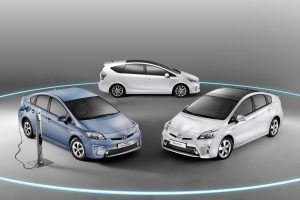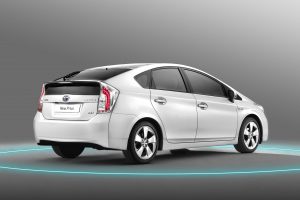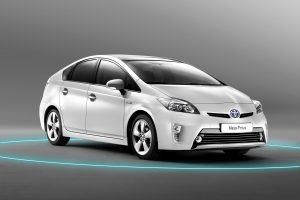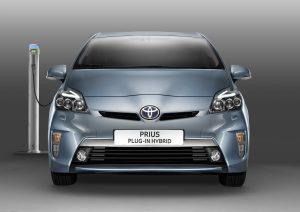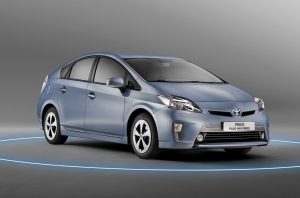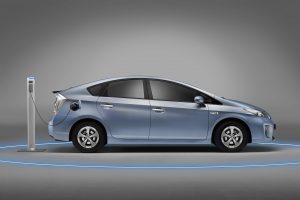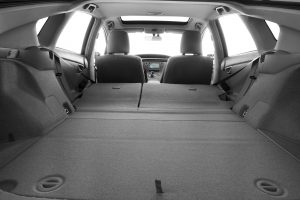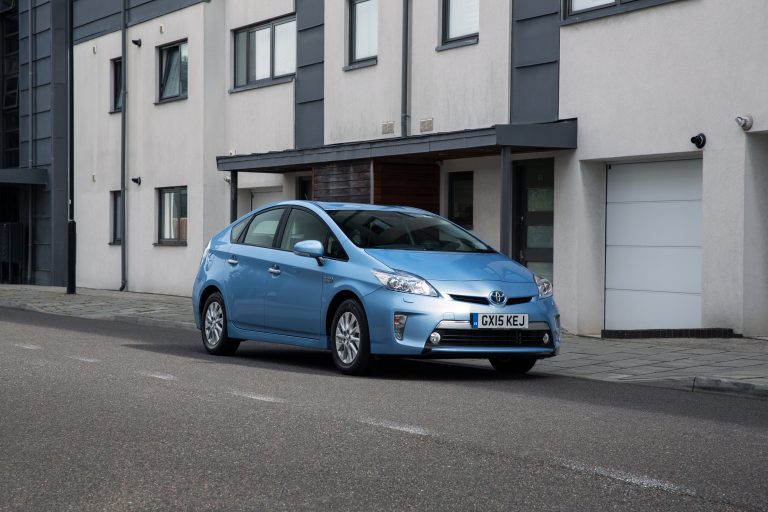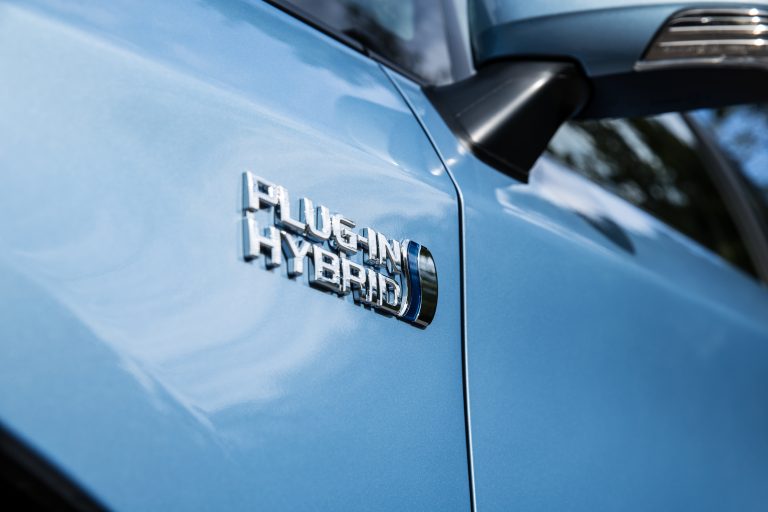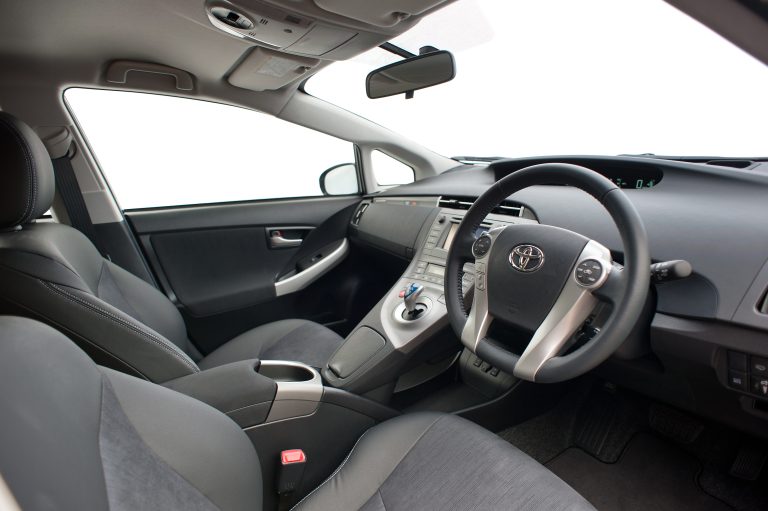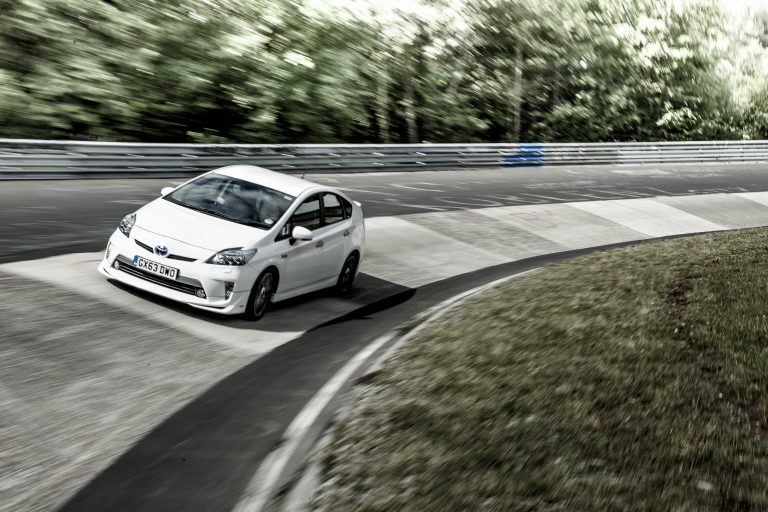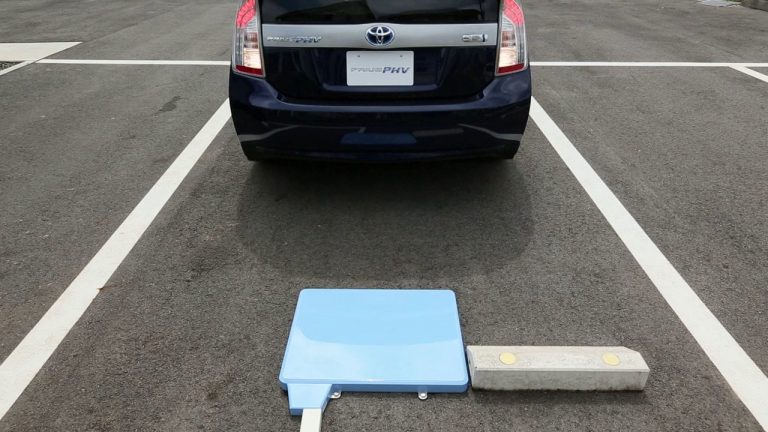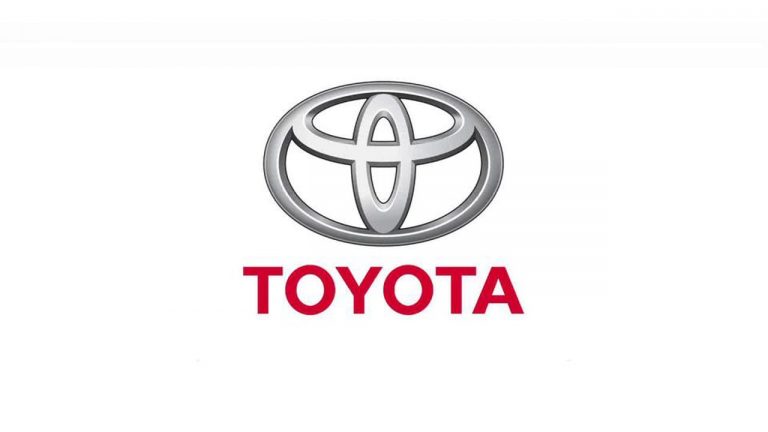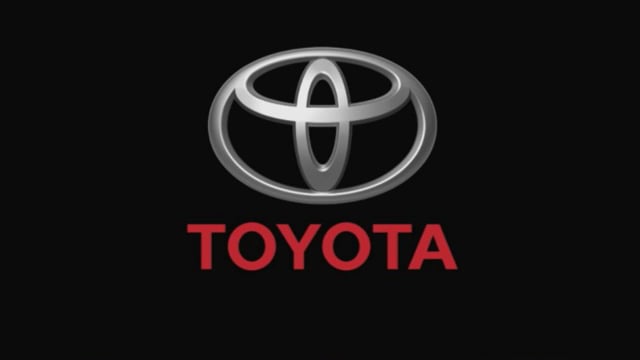The New Prius Family
- Prius is the world’s best selling hybrid – third generation model has already sold more than one million units since launch two years ago
- Toyota plans to launch 10 new hybrids by 2015
- Introducing the Prius family: Prius Plug-in Hybrid, Prius+ and new Prius
Since 1997, Toyota has sold more than 3.3 million full hybrid vehicles worldwide. This represents more than 80 per cent of all global hybrid sales, and gives the company an unquestionable lead in the drive towards sustainable mobility. As concrete proof of HSD’s environmental record, these sales have already contributed to a reduction in automotive emissions of about 21 million tonnes of CO2.
Maintaining its environmental and technological leadership for more than a decade, the multiple award-winning Toyota Prius is the world’s best-selling hybrid with more than 2.3 million units sold. Prius is more popular than ever, and the third-generation model, launched in 2009, has already sold more than 1 million units.
Hybrid Synergy Drive has been specifically designed to be modular and adaptable to different energy sources. Its application in the new Prius Plug-in Hybrid, and Toyota’s ongoing research into Electric Vehicles (EV) and Fuel Cell Hybrid Vehicles (FCHV), offers the potential for even greater reductions in vehicle emissions in the immediate future.
Toyota’s clear lead in hybrid technology has recently been reinforced by an independent study which finds the company is most widely recognised among consumers as a manufacturer of hybrid and electric vehicles.
In a joint survey by Automotive Business Intelligence company EurotaxGlass’s and UK-based marketing and research institute Harris Interactive, 30 per cent of those questioned demonstrated an interest in electric or hybrid vehicles, with Toyota standing out in all markets as the company with the highest brand awareness.
When asked to name an electric or hybrid brand, 15 per cent of survey participants cited Toyota, with only six per cent naming the closest rival hybrid manufacturer. Moreover, Toyota’s environmental flagship proves to be the single best-known electric or hybrid model, with 16 per cent of those questioned being aware of Prius, and only six per cent naming the closest rival vehicle.
Reinforcing Toyota’s belief in the strong potential of the full hybrid technology, the study finds that European consumers are far more open to alternative powertrains than their current market share might suggest.
Pre-empting this conclusion, the launch of the British-built Auris Hybrid marked the start of a significant expansion in the company’s full hybrid model range, which will see the 10 Toyota hybrids introduced by 2015. Toyota aims to offer most of its European models with a Hybrid Synergy Drive powertrain derivative as early as possible in the 2020s.
An important element in this expansion is the positioning of the 2012 Prius as the first full hybrid vehicle to be available as a complete, stand-alone model range: Prius, Prius+ and Prius Plug-in Hybrid. Respective CO2 emissions of 89g/km, 99g/km and a potential 49 g/km* represent unprecedented environmental credentials from an entire model range.
The three models will significantly expand the Prius customer base and subsequent sales; the Prius Plug-in Hybrid appealing to a new group of environmentally conscientious early adopters, and the Prius+ targeting growing European families who require the space and flexibility of a larger, seven-seat vehicle.
THE NEW PRIUS PLUG-IN HYBRID – THE GREENEST, MOST TECHNICALLY ADVANCED PRIUS YET
- Targeting 49g/km CO2 emissions and 134.5mpg fuel consumption
- Targeting EV driving range of about 14.3 miles
- Battery fully rechargeable in 1.5 hours
Prius Plug-in Hybrid, Toyota’s first plug-in hybrid electric vehicle (PHEV) to go on sale to the mass market, makes its production vehicle world debut at the 2011 Frankfurt motor show.
Toyota’s focus on PHEV technology meets current consumer requirements. Recent Accenture research, entitled Plug-in electric vehicles: changing perceptions, hedging bets on the electrification of private transport, suggests that consumers may favour PHEVs over full EVs because they require fewer changes to current driving habits and levels of convenience.
The next major milestone in Toyota’s ongoing, 40 year quest for sustainable mobility and the ultimate eco car, Prius Plug-in Hybrid represents the latest development of the company’s modular Hybrid Synergy Drive platform – credible, trusted and reliable full hybrid technology with a proven track record garnered over more than 200 billion kilometres of driving worldwide.
Offering a considerable expansion of the Hybrid Synergy Drive system’s capabilities, Prius Plug-in Hybrid incorporates a lithium-ion battery to offer an EV driving range of approximately 14.3 miles (target figure). Beyond the electric driving range, it can be used as a conventional full hybrid with all the efficiency of a standard Prius, and fully recharged from a domestic source when convenient, in just an hour-and-a-half.
With a total HSD system power output of 134bhp, Prius Plug-in Hybrid will accelerate from nought to 62mph in 10.7 seconds and reach a top speed of 112mph. Its EV cruising range enables it to achieve remarkable fuel efficiency of 134.5mpg and achieve unprecedented CO2 figures of 49g/km (target figures).
Weighing approximately 1,420kg, Prius Plug-in Hybrid is only 50kg heavier than the regular Prius, and no heavier than any comparable diesel or petrol car in its segment.
Prius Plug-in Hybrid addresses the specific needs of drivers commuting to urban areas, and so will appeal to very similar customers to those who were early adopters of the first generation Prius.
Sales will start in early 2012, mainly in Japan, the USA and Europe, with anticipated annual sales of approximately 50,000 units.
Urban powertrain electrification: the case for Plug-in Hybrid Vehicles
It is estimated that the majority of Europeans will live in urban areas by the end of the decade. As a result, the demand for environmentally-efficient commuter vehicles is expected to increase significantly in the coming years. Based on current conditions, industry attention is now focused on electricity as the most practical energy source.
Many EU member states are struggling to achieve the required EU air quality standards, specifically in towns and cities. This has resulted in local government authorities introducing criteria to restrict the entry of specific types of vehicles to city centres. Following a direction recently proposed in the EU Transport White Paper, some cities are going further and considering a ban on conventional vehicles from city centres and the promotion of electric vehicles.
The environmental merits of electric vehicles (EVs) as urban commuters are well proven, but their further development is currently handicapped by a number of factors. On the technical side, inappropriately large, heavy and costly batteries are required to offer a driving range which only satisfies the needs of those with a very specific usage pattern. Perhaps more significantly, from the customer perspective, no adequate recharging infrastructure yet exists, and range anxiety – the driver’s concern about how far a vehicle will travel on the level of battery charge available – remains a major issue.
Prius Plug-in Hybrid addresses each of these issues, making it the most feasible short to mid-term solution for powertrain electrification.
Building on the core technology of Toyota’s renowned Hybrid Synergy Drive, Prius Plug-in Hybrid sets a new benchmark in environmentally-efficient mobility by giving customers commuting to urban areas the best of both worlds.
It offers an extended, EV driving range, yet it can be driven without any concerns over exceeding the electric power range. At this point, it can be driven as a regular, full hybrid vehicle offering the same environmental credentials and true long-range capability as a standard Prius.
A full hybrid capable of operating in petrol and electric modes alone, the new Prius Plug-in Hybrid rewards customers with stress-free and remarkably quiet operation, while returning unparalleled fuel efficiency and the lowest possible CO2, NOX and PM (Particulate Matter) emissions.
The reduction of CO2 emissions has been a mainstream global issue since the 1990s, and vehicle taxation based on CO2 emissions is now commonplace. However, the focus on curbing CO2 emissions has meant that legislation to limit the pollution of the urban environment through road traffic-generated NOX and PM emissions remains, thus far, significantly less stringent.
Although Euro 6 exhaust emission regulations will bring the diesel engine NOX emission limits closer to those of petrol units (80 versus 60mg/km on the NEDC), Prius Plug-in still generates significantly lower NOX emissions than diesel cars and undercuts the Euro 6 standards by 98 per cent. Moreover, when operating in its extended EV mode, it generates zero CO2, NOX and particulate emissions.
PHEV European Limited Lease Project
Toyota initiated its Plug-in Hybrid Electric Vehicle (PHEV) project in 2007, with road trials of a prototype vehicle in France and the UK in 2008. In 2010, the project entered its second phase when a limited production vehicle, based on the third-generation Prius equipped with a lithium-ion battery, was used for pan-European road trials.
As part of a global Toyota project, 200 vehicles have been leased to selected partners and customers in 18 European countries. France, the UK and Germany are operating150 PHEVs between them, and the largest single group of vehicles is located in Strasbourg, France, where a 70 PHEV-strong project is underway in collaboration with Toyota’s partner, French energy provider EDF, and the City and Urban Community of Strasbourg (CUS).
After nearly a year, the PHEVs involved in the project have been intensively driven both in the urban environment and on longer journeys out of the city. With an average yearly mileage of 8,190 miles for each vehicle, project participants have acquired nearly 497,100 miles of PHEV driving experience.
As two thirds of commutes covering a distance of less than 12.5 miles, the PHEV’s zero-emissions, fully electric range satisfies a significant share of the users’ daily requirements. More than a third of users also completed long distance trips of more than 62 miles at least once a week; the PHEV’s ability to operate as a full hybrid eliminates the range anxiety associated with making journeys of this length in a fully electric vehicle.
Fuel efficiency figures obtained under real-world conditions show that the PHEV consumes 36 per cent less fuel than the comparable, best-in-class diesel vehicle and almost 50 per cent less than the best-in-class petrol vehicle. Users that maximised the potential of the PHEV and made optimal use of the existing recharging infrastructure were able to return average fuel consumption figures of more than 141mpg.
New Prius Plug-in Hybrid, the Hybrid Synergy Drive Technology Flagship
The wealth of real-world user feedback generated by the global limited lease projects has enabled Toyota to re-evaluate every aspect of Prius Plug-in Hybrid’s performance. As a result, the production vehicle benefits not only from several key technological improvements over its lease project counterpart, but also considerable improvements to its everyday practicality and usability.
Prius Plug-in Hybrid features a new lithium-ion battery with a high capacity of 4.4kWh and a weight of only 80kg. This compares favourably to the nickel-metal hydride battery of the latest generation Prius, which has a capacity of 1.3kWh and weighs 42kg.
Using a battery charger inlet now relocated beneath a discreet, flush-mounted panel in the production vehicle’s right-hand rear wing, the battery pack can be fully recharged in 1.5 hours from a standard, 230V household outlet, with no need for an expensive fast-charger.
Driving Modes
Prius Plug-in Hybrid offers the driver three switchable, ‘on-demand’ drive modes: HV, EV and EV-City.
With HV mode selected, Prius Plug-in Hybrid functions like a standard Prius. It delivers the classic, highly efficient Toyota HSD driving experience, seamlessly engaging the petrol engine as appropriate. The vehicle’s switchable EV mode range is preserved for use in urban environments.
With EV mode selected, Prius Plug-in Hybrid is able to draw upon the full capacity of the battery and will remain in electric drive mode, allowing for urban driving with minimal noise and zero CO2 and NOX emissions, for up to approximately 14.5 miles at speeds of up to 53mph.
The petrol engine will still start if the system judges that additional power is necessary, however the use of light to medium throttle inputs keeps it switched off throughout EV mode operation.
With EV-City mode selected, the Prius Plug-in Hybrid matches the EV mode’s characteristics. Increased electric operation is ensured by allowing more forceful use of the throttle before the petrol engine kicks in.
Switched separately, ECO mode may be independently activated when the Prius Plug-in Hybrid is operating in HV, EV or EV-City modes. In any drive mode, throttle response to accelerator pedal inputs is reduced and air-conditioning control adjusted for improved fuel economy. Depending on driving conditions, ECO mode can help drivers achieve a perceptible reduction in fuel consumption.
Exclusive design with practical and technologically advanced interior
In recognition of its status as the next generation eco car from the Toyota hybrid stable, several subtle exterior detail changes differentiate Prius Plug-in Hybrid from the standard Prius.
The front of the car features an exclusive grille and front bumper design. To the rear, a clear lens combination lamp design further differentiates the new vehicle from the standard Prius. A high-brightness silver finish has been adopted for the door handles, licence plate trim and battery charger lid, and the vehicle features Plug-in Hybrid badging on the front wings and tailgate.
Following lease customer feedback, the battery charger inlet has been relocated from the left front wing to a discreet, flush-mounted panel in the right-hand rear wing. Every aspect of the charging operation itself has also been reconsidered.
The Charge Circuit Interface Device (CCID) has been made more compact, and a 25 per cent lighter, more flexible charging cable that does not stiffen in cold weather has been developed. The battery charger lid has been incorporated into the cover for easier, single-operation closing, and it now features a battery charger indicator and LED illumination for better night-time visibility. As an additional safety measure, Prius Plug-in Hybrid cannot be started when the charging cable is connected.
On board, the quality of the interior has been raised through a new colour scheme with silver inserts, a revised centre console design, and an improved multi-information display with improved EV driving support meter functions.
The air conditioning is coordinated with the standard front seat heaters. This enables the system to reach a comfortable temperature for the driver and passenger more quickly and efficiently, further improving the vehicle’s fuel efficiency.
The installation of the new, more compact lithium-ion battery has allowed for a loadspace deck that is on a par with the standard Prius, and a luggage capacity of 443 litres. Under-boot storage of 40.5 litres means there is ample space to store the charging cable beneath the loadspace floor.
Advanced and affordable multimedia systems
Reflecting today’s highly connected society, on-board multimedia systems are in increasing demand. Placing a particularly high value on touch-screen operation, customers require a system which gives centralised control of the widest possible range of vehicle functions, as well as connectivity to external devices such as mobile phones and portable music players.
In response, the new Prius Plug-in Hybrid, gives customers a unique range of multimedia equipment choices, from the most affordable touch screen interface to the most sophisticated satellite navigation yet created by Toyota, as well as a new, power-saving JBL premium sound system.
Toyota Touch
Fitted as standard, Toyota Touch is a 6.1-inch, full colour, touch-screen interface which represents a new approach to affordable, on-board multimedia systems. With a choice of seven European languages, it offers customers a wide range of interactive functions without the added expense of an integral satellite navigation system.
It incorporates an AM/FM radio with enhanced FM reception through the first use of two tuners and two antennae; a CD/MP3 player; Bluetooth mobile phone connectivity with a music streaming facility; and a USB port for the connection of portable music players, with the facility to display iPod album cover art. In addition, a rear-view camera is fitted as standard.
Toyota Touch and Go Plus
Building on the Toyota Touch multimedia base unit, Toyota Touch and Go Plus equips Prius Plug-in Hybrid with an optional navigation system that represents the best value for money on the market. With a choice of 14 languages, it includes all the most popular navigation functions, such as advanced traffic coverage, customisable speed limits, speed camera warnings, 3D city models and landmarks.
Toyota Touch Pro
The launch of new Prius Plug-in Hybrid will also mark the introduction of the most sophisticated satellite navigation system yet offered by the company, the new Toyota Touch Pro.
This premium quality multimedia system features a high-resolution 7.0-inch touch-screen interface with a ‘home’ screen, at-a-glance function displaying the most relevant air-conditioning, audio and navigation information. With a choice of 20 menu and guidance languages, the system covers the whole of Europe.
It offers a comprehensive range of advanced features including voice recognition, automatic map zoom at intersections, 3D city model and landmark graphics, an on-line Points Of Interest search facility and a supplementary driver’s navigational guidance head-up display.
The system also provides access to SMS messages and emails, and includes a ‘text-to-speech’ message readout facility. A rear-view camera with dynamic guidance lines to help manoeuvring in confined spaces is fitted as standard.
Toyota Touch Pro also incorporates DAB/DAB+/DMB digital radio as standard, making it compatible with a new advanced Transport Protocol Export Group (TPEG) traffic information service (depending on DAB/TPEG availability). Based on a digital communication channel, TPEG represents a significant improvement over existing, RDS-TMC analogue systems because it can carry far more information (depending on market).
Not only will its pin-point accuracy enable better navigation routing, but it will also supplement a basic traffic event and flow service with information on parking availability and fuel prices, adding extra information such as speed limits and weather thereafter.
JBL GreenEdge premium sound system
Prius Plug-in Hybrid introduces another Toyota first, a new JBL Premium Sound System which features GreenEdge. This technology helps to maximise energy efficiency by reducing operational power requirements by up to 80 per cent of those of a conventional on-board audio system.
At the heart of the system is a JBL GreenEdge amplifier, which is 66 per cent smaller and lighter than comparable units. Because the amplifier’s Tracking Power Technology measures audio input in real time, only the necessary electricity is provided to the amplification circuit. This greatly reduces heat loss, and effects a 50 per cent reduction in current consumption.
High-efficiency JBL GreenEdge speakers consume 50 per cent less power than conventional speakers for the same sound output levels. They feature custom designed acoustic lenses to spread a more powerful sound across an even wider frequency range.
| Audio | NaviGATION | |
| TOYOTA TOUCH | TOYOTA TOUCH AND GO PLUS | TOYOTA TOUCH PRO |
| Functions added toENTRY AUDIO: | Functions added toTOYOTA TOUCH : | Functions added toTOYOTA TOUCH & GO PLUS: |
| 6.1” touch-screenBluetoothRear-view camera
Automatic phone book access and audio streaming iPod album cover display Vehicle settings* A/C pop-up display |
11 speakersTraffic patterns3D landmarks and city models
Email and Calendar** ‘Play More Like This’ music search Advanced Voice Recognition Text to speech 3-year map and software updates/upgrades |
7” touch-screen with a ‘home’ screen20 menu and guidance languagesNavigational guidance head-up display
Access to SMS messages and emails DAB/DAB+/DMB digital radio |
| JBL GreenEdge: optional | JBL GreenEdge: optional | JBL GreenEdge: standard |
* Vehicle settings availability varies per model and grade
** Bluetooth Message Across Profile required on the mobile phone
Smart Grid for the future mobility society
Toyota’s next-generation, environmentally-efficient PHEVs and EVs will become a key element of the social system and play an important role in realising a low-carbon society.
However, the amount of electricity these vehicles consume while recharging accounts for a substantial part of an ordinary household’s total power consumption. And if many vehicles charge their batteries simultaneously during specific hours of the day, it will boost overall peak power demand. It is, therefore, crucial that this charging time is optimally controlled.
In response to these requirements, Toyota is working on the Smart Grid concept – an electricity network wherein power supply and demand are efficiently controlled using IT to ensure a stable power supply and optimum energy saving.
The Smart Grid is designed to help customers live a comfortable, low-carbon eco-life by connecting vehicles, homes and people. At the heart of the Smart Grid is Toyota Home’s Smart House, currently on test in Japan.
The Smart House is equipped with a Home Energy Management System (HEMS), which controls the generation of electricity by solar panels, its storage in a home battery and its efficient consumption, including vehicle charging times. The PHEV or EV is integral to the system, and the vehicle battery may be used as a household power source in emergencies.
Smart House occupants’ smart phones are also integrated into the system, monitoring home power consumption and facilitating the remote control of appliances to support an eco-lifestyle. In addition, the smart phone will also check PHEV or EV battery level, set battery charging time and control the vehicle’s remote air conditioning to help support eco-driving.
The Smart Houses in each district are connected to a Toyota Smart Centre; a local information centre which monitors power company and home electricity generation, and each home’s power usage. The Smart Centre plans power consumption and storage, and gives advice where necessary to help level power demands and ensure that electricity is efficiently used throughout the entire community.
To establish the Smart Grid, advanced IT technologies and large-scale information infrastructures are necessary, while cooperation among various industries and government agencies is essential. To that end, Toyota is already participating in tests to evaluate the next generation of eco-cars and introduce the Smart Grid on a global scale.
In Japan, a Ministry of Economy, Trade and Industry (METI) programme is promoting PHEVs and EVs in 18 designated model prefectures such as Aichi, Osaka and Kyoto, encouraging their use as public service vehicles. METI-supported, next-generation energy/social system projects at Toyota City and Kitakyushu City are both developing a low-carbon community from the consumer’s viewpoint and testing factory management systems for industrial cities.
In Rokkasho Village, Aomori, another TMC project covers all power requirements for homes and PHEVs with natural, wind and solar power energy, and is conducting various tests for the establishment of a Toyota Smart Centre.
In the United States, the world’s first whole-town Smart Grid demonstration project is underway in Boulder City, Colorado. Led by local power companies, the project will evaluate the PHEV’s usability, charging performance and connection with homes.
In Tianjin City, China, a joint project with the China Automotive Technology and Research Centre (CATARC) will evaluate the usability and charging performance of the PHEV.
In France, as part of a larger study on the energy convergence between solar power, buildings and transport, 10 Toyota PHEVs are involved in projects which focus on the use of solar power for recharging. The trials, taking place at the National Institute of Solar Energy (INES) in Chambery and the Agency for Atomic Energy and Alternative Energies (CEA) in Grenoble, are designed to maximise the use of solar energy and minimise fossil fuel requirements in a recharging infrastructure.
PRIUS+: THE PRIUS FOR PEOPLE WHO NEED MORE PRIUS
- First European MPV to combine seven seats with a full hybrid powertrain
- Class leading 0.28 drag coefficient
- Class-leading combined cycle fuel economy of 65.7mpg and 99g/km CO2 emissions
Prius+, a seven-seat MPV based on Toyota’s full hybrid Prius, makes its production car European debut at the 2011 Frankfurt motor show, ahead of going on sale throughout Europe in the first half of 2012.
Prius+ is the first car to offer European customers the versatility of seven seats combined with a full hybrid powertrain, broadening the appeal of Hybrid Synergy Drive’s environmental credentials and advanced technology to the widest customer base yet.
Prius+ is a new vehicle, designed from the ground up. Its exterior design hallmarks it as an evolution, rather than merely an elongated version, of the standard Prius.
The sleek, bold styling features an extended roofline with an integral, panoramic sunroof, retaining the Prius triangle silhouette and giving the vehicle a class leading Cd 0.28 drag coefficient.
The trapezoidal front incorporates sharp-edged headlamps, turbulence-minimising aero-corners and an enlarged lower grille. Distinctive rear styling is highlighted by a practical, top hinged tailgate, a roof spoiler to further improve airflow and intricate combination lamp clusters located as far outward as possible to allow for the widest possible luggage compartment opening.
As its name suggests, Prius+ provides a significant increase in space and passenger accommodation. It is 155mm longer than a standard Prius, 30mm wider, and 85mm higher, with a wheelbase extended by 80mm, giving enough room to accommodate adults in all three rows of seats.
The architecture of the all- new interior design features a strong horizontal dashboard line which encompasses the centre console, centre cluster and instrumentation in one flowing form. Combined with concave door trim and a well-defined centre space between console and cluster, this creates an great feeling of spaciousness.
The openness of the interior is further enhanced by a large, resin panoramic sunroof. A first for a Toyota vehicle, this material and its construction system make it 40 per cent lighter than its glass equivalent. It also has a higher level of heat-resistance. The sunroof includes a door lock-linked automatic shade closing function to prevent cabin temperature from rising when the car is parked in hot weather.
The innovative air conditioning control concentrates the most frequently used functions into a single dial, allowing easy, intuitive operation.
The seven-seat format features three, independent, split/folding second row seats and a 50:50 split/folding third tier. Clear forward visibility for all occupants has been achieved by raising the seat height in each row by 45mm over the one in front, while maintaining ample head clearance and legroom in every row.
Even with seven passengers on board, Prius+ provides 200 litres of cargo space. With the third seating row stowed, this figure rises to 505 litres. A 1,105mm tailgate opening width, 95mm wider than that of the standard Prius, makes for easy loading and unloading, and storage flexibility is provided with a large, 345mm storage tray beneath the luggage deck.
The adoption of third-row seating has been made possible by the installation of a highly compact, space-saving lithium-ion battery pack within the vehicle centre console between the front seats, offering no compromise to the seven-seat passenger accommodation or loadspace.
This is the first lithium-ion battery to be used in a non-plug-in Toyota full hybrid.
Prius+ showcases the latest generation of Toyota’s Hybrid Synergy Drive powertrain, which employs a 1.8-litre 98bhp Atkinson cycle petrol engine and a powerful, 60kW electric motor. Total system power is 134bhp, enabling Prius+ to accelerate from nought to 62mph in 11.8 seconds and reach a top speed of 106mph.
Prius+’s environmental performance is enhanced by its class-leading aerodynamics and low weight. The full hybrid drive system returns both class-leading fuel economy and CO2 emissions, 65.7mpg and 99g/km respectively.
As in the standard Prius, Prius+ features three ‘on-demand’ drive modes to increase the full hybrid powertrain’s capabilities: an EV mode allows for ultra-quiet running on electric motor power alone for up to 1.2 miles, with zero fuel consumption and tailpipe emissions; ECO mode prioritises fuel economy by dampening throttle response and limiting power consumption from the air conditioning system; and POWER mode boosts system performance.
A Head-Up Display (HUD) and smart entry system are included as standard equipment while LED headlamps, Adaptive Cruise Control (ACC) and Pre-Crash Safety (PCS) systems are available. Just as in the standard Prius, customers are offered a range of advanced convenience and safety features to choose from.
As with every vehicle in the new Prius family, Prius+ benefits from a range of touch-screen multimedia equipment. Toyota Touch is fitted as standard. Toyota Touch and Go Plus and Toyota Touch Pro navigation systems, and a JBL Matrix Premium Sound System featuring GreenEdge technology are available as options (see Prius Plug-in Hybrid Chapter for full details).
Prius+ goes on sale throughout Europe in the first half of 2012, with a sales target of around 18,000 units a year.
PRIUS, THE ORIGINAL FULL HYBRID UPDATED
- Improvements to interior and exterior design, and quality appeal
- Prius remains a front-runner in the field of technological innovation while leading Toyota’s European full hybrid deployment strategy
Making its world debut at the 2011 Frankfurt motor show, the refreshed Prius features further improvements to its exterior and interior design, and a new range of advanced and affordable multimedia systems.
The world’s first mass-produced full hybrid vehicle, Prius was launched in Japan in 1997, and in Europe in 2000. While rival manufacturers are only now introducing a first hybrid variant to their existing model ranges, the stand-alone Prius has already entered its third generation.
With global sales having passed 2.3 million units, Prius maintains a peerless reputation for reliability, durability and low cost of ownership.
Voted Car of the Year by European, Japanese and American motoring journalists, it has won numerous prestigious awards, and its Hybrid Synergy Drive is one of the most successful powertrains in the history of the International Engine of the Year awards, with 11 honours to date.
Prius has been consistently ahead of its time in addressing not only CO2 emissions, but also air quality. Even operating in normal drive mode, it generates significantly lower NOX emissions than any comparable diesel or petrol vehicle. In EV mode, with a range of up to 1.4 miles, it generates zero CO2, NOX and PM tailpipe emissions.
Internal Toyota studies performed with the third-generation Prius show that during a typical city trip, when the average speed is below 19mph, more than 25 per cent of the journey takes place with the engine off, resulting in considerable reductions in average fuel consumption and emissions.
The last decade has witnessed a fall in the fuel consumption of its Hybrid Synergy Drive powertrain of more than 23 per cent and a reduction in CO2 emissions of almost 26 per cent. Yet system power has simultaneously increased by 30 per cent. The latest Prius returns 72.4mpg in the combined cycle, and generates CO2 emissions of 89 g/km.
Customer perceptions of full hybrid technology have also evolved significantly over the last decade. First-generation Prius owners were won over by the car’s unique concept and technological innovation. Second-generation owners were enthusiastic early adopters of niche technologies, remaining passionate about the Prius product concept regardless of the opinions of others.
Third-generation customers, however, recognise Prius as a true mainstream vehicle with on-road performance and dynamic abilities which bear comparison with conventional D-segment competitors.
New Prius features a new, more dynamic frontal treatment. The revised front bumper design places the emphasis on an enlarged lower grille, in keeping with the new face of the next generation Toyota family. A new, clear lens headlamp design features a revised LED lamp configuration, and daytime running lights have been incorporated in the bumper.
The door mirrors now have a power-folding function, the rear combination lamps have been redesigned and there is a new 15-inch wheel design.
On board, the quality of the appearance and feel of the interior have been raised through a change of colour scheme from dark grey to black, the addition of silver inserts and an upholstery upgrade.
The centre console has been revised, and the push start button colour changed to hybrid blue. The multi-information display has been improved with a 16-gradation-step Vacuum Fluorescent Display (VFD) which gives a clearer and more three-dimensional display, and driving support functions now include an EV indicator lamp.
Prius remains a front-runner in the field of technological innovation. Each generation has introduced new, high technology features to the segment ahead of their time.
The third generation Prius showcased a head-up display, Touch Tracer switchgear and a Pre-Crash Safety system. It was also equipped with the world-first combination of a solar ventilation system and remote-controlled air conditioning. The solar powered ventilation prevents the interior air temperature from rising whilst the Prius is parked. In conjunction, the air conditioning may be activated remotely, using the large capacity hybrid battery to cool the interior for up to three minutes before vehicle occupancy.
New Prius benefits from the addition of a range of advanced and affordable multimedia equipment choices being introduced to every vehicle in the new Prius family; Toyota Touch, Toyota Touch and Go Plus, the new Toyota Touch Pro, and a new JBL Matrix Premium Sound System with GreenEdge energy-saving technology (see Prius Plug-in Hybrid Chapter for full details).
Prius will continue to lead Toyota’s European full hybrid deployment strategy. With other Toyota HSD models introducing the benefits of full hybrid drive to an ever-wider customer base, Prius will remain a showcase for new technologies and further advances in HSD powertrain design.
ENDS

